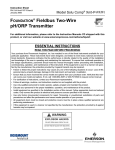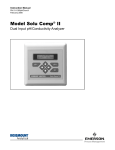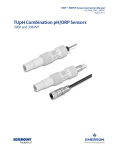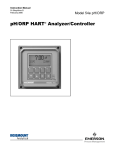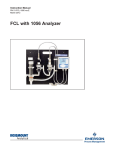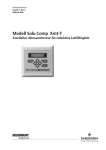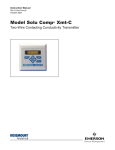Download Emerson Solu Comp Xmt-P-FF/FI Specifications
Transcript
Instruction Sheet PN 51A-Xmt-P-FF-FI/rev.F October 2010 Model Solu Comp™ Xmt-P-FF/FI FOUNDATION® Fieldbus Two-Wire pH/ORP Transmitter For additional information, please visit our website at www.emersonprocess.com/raihome/liquid/. ESSENTIAL INSTRUCTIONS READ THIS PAGE BEFORE PROCEEDING! Your purchase from Rosemount Analytical, Inc. has resulted in one of the finest instruments available for your particular application. These instruments have been designed, and tested to meet many national and international standards. Experience indicates that its performance is directly related to the quality of the installation and knowledge of the user in operating and maintaining the instrument. To ensure their continued operation to the design specifications, personnel should read this manual thoroughly before proceeding with installation, commissioning, operation, and maintenance of this instrument. If this equipment is used in a manner not specified by the manufacturer, the protection provided by it against hazards may be impaired. • Failure to follow the proper instructions may cause any one of the following situations to occur: Loss of life; personal injury; property damage; damage to this instrument; and warranty invalidation. • Ensure that you have received the correct model and options from your purchase order. Verify that this manual covers your model and options. If not, call 1-800-854-8257 or 949-757-8500 to request correct manual. • For clarification of instructions, contact your Rosemount representative. • Follow all warnings, cautions, and instructions marked on and supplied with the product. • Use only qualified personnel to install, operate, update, program and maintain the product. • Educate your personnel in the proper installation, operation, and maintenance of the product. • Install equipment as specified in the Installation section of this manual. Follow appropriate local and national codes. Only connect the product to electrical and pressure sources specified in this manual. • Use only factory documented components for repair. Tampering or unauthorized substitution of parts and procedures can affect the performance and cause unsafe operation of your process. • All equipment doors must be closed and protective covers must be in place unless qualified personnel are performing maintenance. • If this equipment is used in a manner not specified by the manufacturer, the protection provided by it against hazards may be impaired. WARNING EXPLOSION HAZARD DO NOT OPEN WHILE CIRCUIT IS LIVE DO NOT RUB OR CLEAN WITH SOLVENTS 9241589-00/A MODEL Xmt-P SPECIFICATIONS SPECIFICATIONS - GENERAL Case: ABS (panel mount), polycarbonate (pipe/surface ount). Both versions are NEMA 4X/CSA 4 (IP65). Dimensions Panel (code -10): 6.10 x 6.10 x 3.72 in. (155 x 155 x 94.5 mm) Surface/Pipe (code -11): 6.23 x 6.23 x 3.23 in. (158 x 158 x 82 mm); see page 5 for dimensions of pipe mounting bracket. Conduit openings: Accepts PG13.5 or 1/2 in. conduit fittings Ambient Temperature: 32 to 122°F (0 to 50°C). Some degradation of display above 50°C. Storage Temperature: -4 to 158°F (-20 to 70°C) Relative Humidity: 10 to 90% (non-condensing) Weight/Shipping Weight: 2 lb/3 lb (1 kg/1.5 kg) Display: Two line, 16-character display. Character height: 4.8 mm; first line shows process variable (pH, ORP, conductivity, % concentration, oxygen, ozone, chlorine, or monochloramine), second line shows process temperature and output current. For pH/chlorine combination, pH may also be displayed. Fault and warning messages, when triggered, alternate with temperature and output readings. During calibration and programming, messages, prompts, and editable values appear on the two-line display. Temperature resolution: 0.1°C (≤99.9°C); 1°C (≥100°C) Hazardous Location Approval: For details, see specifications for the measurement of interest. RFI/EMI: EN-61326 Sira MC070113/00 Power & Load Requirements: A power supply voltage of 9-32 Vdc at 13 mA is required. FUNCTIONAL SPECIFICATIONS pH Range: 0 to 14 ORP Range: -1400 to +1400mV Calibrations/standardization: The automatic buffer recognition uses stored buffer values and their temperature curves for the most common buffer standards available worldwide. The transmitter also performs a stabilization check on the sensor in each buffer. A manual two-point calibration is made by immersing the sensor in two different buffer solutions and entering the pH values. The microprocessor automatically calculates the slope which is used for self-diagnostics. An error message will be displayed if the pH sensor is faulty. This slope can be read on the display and/or manually adjusted if desired. An on-line one-point process standardization is accomplished by entering the pH or ORP value of a grab sample. Preamplifier Location: A preamplifier must be used to convert the high impedance pH electrode signal to a low impedance signal for transmitter use. The integral preamplifier of the Model Xmt-P may be used when the sensor to transmitter distance is less than 15 ft (4.5 m). Locate the preamplifier in the sensor or junction box for longer distances. Automatic Temperature Compensation: External 3 or 4 wire Pt 100 RTD or Pt 1000 RTD located in the sensor, compensates the pH reading for temperature fluctuations. Compensation covers the range -15 to 130°C (5 to 270°F). Manual temperature compensation is also selectable. Accuracy: ± 1 mV @ 25°C ± 0.01 pH Repeatability: ± 1 mV @ 25°C ± 0.01 pH Stability: 0.25% / year @ 25°C Diagnostics: The internal diagnostics can detect: Calibration Error Sensor Failure High Temperature Warning CPU Failure Low Temperature Warning Input Warning ROM Failure Glass Warning Glass Failure Reference Warning Reference Failure Once one of the above is diagnosed, the display will show a message describing the problem. Digital Communications: Fieldbus (pH): Four AI blocks assigned to pH, temperature, reference impedance, and glass impedance. Fieldbus (ORP): Three AI blocks assigned to ORP, temperature, and reference impedance. Fieldbus (pH and ORP): Execution time 75 msec. One PID block; execution time 150 msec. Device type 4085. Device revision 1. Certified to ITK 4.5. 2 MODEL Xmt-P SPECIFICATIONS Intrinsic Safety: Non-Incendive: Class I, II, III, Div. 1 Class I, Div. 2, Groups A-D Groups A-G Dust Ignition Proof T4 Tamb = 50°C Class II & III, Div. 1, Groups E-G NEMA 4/4X Enclosure Class I, II, III, Div. 1 Groups A-G Class I, Div. 2, Groups A-D T4 Tamb = 50°C Dust Ignition Proof Class II & III, Div. 1, Groups E-G ATEX 1180 II 1 G Baseefa04ATEX0213X NEMA 4/4X Enclosure T4 Tamb = 50°C EEx ia IIC T4 Tamb = 0°C to 50°C PROCEDURE — QUICK STANDARDIZATION CALIBRATION The pH measured by the transmitter can be changed to match the reading from a second or referee instrument. The process of making the two readings agree is called standardization. During standardization, the difference between the two values is converted to the equivalent voltage. The voltage, called the reference offset, is added to all subsequent measured cell voltages before they are converted to pH. If after standardization the sensor is placed in a buffer solution, the measured pH will differ from the buffer pH by an amount equivalent to the standardization offset. 1. Install the pH sensor in the process liquid. 2. Once readings are stable, measure the pH of the liquid using a referee instrument. 3. Because the pH of the process liquid may change if the temperature changes, measure the pH of the grab sample immediately after taking it. 4. For poorly buffered samples, it is best to determine the pH of a continuously flowing sample from a point as close as possible to the sensor. 5. From the main display, press ENTER 3 times within 5 seconds. 6. The top line shows the present reading. Use the arrow keys to change the pH reading in the second line to match the pH reading from the referee instrument. 7. The screen at left appears if the entered pH was greater than 14.00 or if the mV offset calculated by the transmitter during standardization exceeds the reference offset limit programmed into the transmitter. The display then returns to the main display. Repeat the standardization. To change the reference offset from the default value (60 mV), see section 7.4. 8. If the entry was accepted the display returns to the main display. *Quick Standardization allows the Xmt-P-FF Fieldbus Transmitter to be standardized without the need to set the Transducer Block to the Out of Service Mode. The measured pH status remains good and prevents any subsequent function blocks linked to the Transducer Block from going to the Out of Service Mode, or exhibiting spurious block errors. 3 QUICK START GUIDE FOR MODEL SOLU COMP Xmt-P-FF/FI TRANSMITTER 1. Refer to page 5 for installation instructions. 2. Wire pH or ORP sensor to the transmitter. See Figure 6 for panel mount; Figure 7 for pipe or surface mount. Refer to the sensor instruction sheet for details. 3. Once connections are secure and verified, apply power to the transmitter. 4. When the transmitter is powered up for the first time, Quick Start screens appear. Using Quick Start is easy. a. A blinking field shows the position of the cursor. b. Use the ⇐ or ⇒ key to move the cursor left or right. Use the ⇑ or ⇓ key to move the cursor up or down or to increase or decrease the value of a digit. Use the ⇑ or ⇓ key to move the decimal point. c. Press ENTER to store a setting. Press EXIT to leave without storing changes. Pressing EXIT also returns the display to the previous screen. English Español Français >> pH Measure? Redox Sensor/JBox 7. Choose preamplifier location. Select Xmtr to use the integral preamplifier in the transmitter; select Sensor/JBox if your sensor has an integral preamplifier or if you are using a remote preamplifier located in a junction box. 8. Choose temperature units: °C or °F. Temperature in? °C 6. Choose measurement: pH, ORP, or Redox. ORP Use Preamp in? Xmtr 5. Choose the desired language. Select >> to show more choices. °F 9. To change output settings, to scale the 4-20 mA output, to change measurement-related settings from the default values, and to set security codes, press MENU. Select Program and follow the prompts. Refer to the appropriate menu tree (page 11). 10. To return the transmitter to default settings, choose ResetAnalyzer in the Program menu. 4 MODEL Xmt-P INSTALLATION UNPACKING AND INSPECTION Inspect the shipping container. If it is damaged, contact the shipper immediately for instructions. Save the box. If there is no apparent damage, unpack the container. Be sure all items shown on the packing list are present. If items are missing, notify Emerson Process Management immediately. INSTALLATION 1. Although the transmitter is suitable for outdoor use, do not install it in direct sunlight or in areas of extreme temperatures. FIGURE 1. Removing the Knockouts 2. Install the transmitter in an area where vibrations and electromagnetic and radio frequency interference are minimized or absent. 3. Keep the transmitter and sensor wiring at least one foot from high voltage conductors. Be sure there is easy access to the transmitter. 4. The transmitter is suitable for panel (Figure 3), pipe (Figure 4), or surface (Figure 5) mounting. 5. The transmitter case has two 1/2-inch (PG13.5) conduit openings and either one or four 1/2-inch knockouts. The panel mount Xmt-P-FF/FI has four knockouts. The pipe/surface mount transmitter has two knockouts*. One conduit opening is for the power/output cable; the other opening is for the sensor cable. Figure 1 shows how to remove a knockout. The knockout grooves are on the outside of the case. Place the screwdriver blade on the inside of the case and align it approximately along the groove. Rap the screwdriver sharply with a hammer until the groove cracks. Move the screwdriver to an uncracked portion of the groove and continue the process until the knockout falls out. Use a small knife to remove the flash from the inside of the hole. (9 - 32 VDC) 6. Use weathertight cable glands to keep moisture out to the transmitter. If conduit is used, plug and seal the connections at the transmitter housing to prevent moisture from getting inside the instrument. 7. To reduce the likelihood of stress on wiring connections, do not remove the hinged front panel (-11 models) from the base during wiring installation. Allow sufficient wire leads to avoid stress on conductors. FIGURE 2. Power Supply/Current Loop Wiring *NEMA plug may be supplied instead of knockout for pipe/surface version. 5 MODEL Xmt-P INSTALLATION Panel Mounting. MILLIMETER INCH FIGURE 3. Panel Mount Installation Access to the wiring terminals is through the rear cover. Four screws hold the cover in place. 6 MODEL Xmt-P INSTALLATION Pipe Mounting. MILLIMETER INCH FIGURE 4. Pipe Mount Installation The front panel is hinged at the bottom. The panel swings down for access to the wiring terminals. 7 MODEL Xmt-P INSTALLATION Surface Mounting. MILLIMETER INCH FIGURE 5. Surface Mount Installation The front panel is hinged at the bottom. The panel swings down for access to the wiring terminals. 8 MODEL Xmt-P INSTALLATION FIGURE 6. Loop Power and Sensor Wiring - Panel Mount 9 FIGURE 7. Loop Power and Sensor Wiring - Pipe/Surface Mount 10 11 MENU TREE FOR MODEL SOLU COMP Xmt-P-FF/FI TRANSMITTER MAIN MENU Language SENSOR COMPATIBILITY CHART pH/ORP SENSOR 320HP-58 328A 370 371 372 381 pHE-31-41-52 381+ 385+ 389-02-54 / 389VP-54 396-54-62 / 396VP 396P-55 / 396PVP-55 396R / 396RVP-54 397-54-62 398-54-62 / 398VP-54 398R-54-62 / 398RVP-54 399-09-62 / 399VP-09 / 399-14 Hx338 Hx348 TF396 The right people, the right answers, right now. DIAGNOSTIC CAPABILITY Glass only Glass only Glass only Glass only Glass only Glass only Glass and Reference Glass and Reference Glass only Glass only Glass and Reference Glass and Reference Glass only Glass only Glass only Glass only Glass only Glass only none ON-LINE ORDERING NOW AVAILABLE ON OUR WEB SITE http://www.raihome.com Specifications subject to change without notice. 8 Credit Cards for U.S. Purchases Only. Emerson Process Management 2400 Barranca Parkway Irvine, CA 92606 USA Tel: (949) 757-8500 Fax: (949) 474-7250 http://www.raihome.com © Rosemount Analytical Inc. 2010












